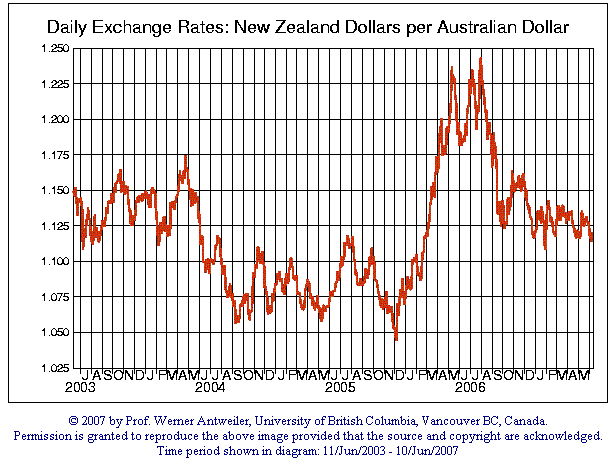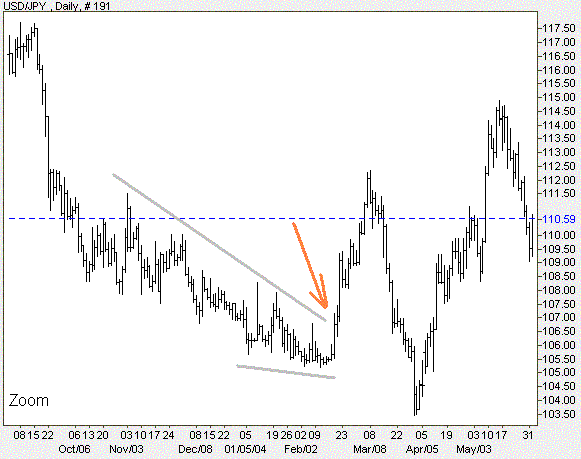Central Bankers May Get It Wrong This Time
On June 14th, the online edition of The Economist published an article titled
‘A warning shot’ – an attempt to see through the premises of the recent Reserve
Bank of New Zealand’s foreign exchange intervention which hit the currency
markets in the early hours of June 11th. At some point the author writes, ‘It
was a well-timed intervention’.
From a purely technical standpoint, I tend to disagree. To me it looks like
the New Zealand’s central bank easily ignored an obvious, yes – although not yet
out-of-hand, rampant (and hence, potentially nearby notable exhaustion) – deal
of strength that had been fuelling gains of the New Zealand Dollar against the
US Dollar as well as via the currency’s cross pairs. Reversing or even
decelerating those uptrends, not yet vulnerable, would have required remarkable
efforts and perhaps still is too difficult to do at this time.
The following daily chart snapshot of the AUD/NZD, taken just one day before
the June 11th intervention, may offer a compelling visual clue of the New
Zealand Dollar’s underlying strength and strengthening via one of its main
crosses.
(copyright (C) 2007 Prof. Werner Antweiler, University of British Columbia,
Vancouver BC, Canada)
In January 2004, although a large part of the mainstream media was at the time
engaged in talking down the US Dollar versus the Japanese Yen, what I thought
was the USD/JPY could find an interim bottom at around 105 and then soar in a
positive correction able to target 110, perhaps even 112 before losing steam.
I wrote once I never seek an involvement in sophisticated markets because –
for one – I am not a sophisticated player. When I publicly made that call in
early 2004, my observations were entirely technical. Basically, I thought the
USD/JPY had already been performing on a tightrope just as a large ‘falling
wedge’ type of chart pattern was about to climax.
I don’t even recall the generic fundamentals that were making the rounds at
that time.
Then again, there should be no ‘just generic’ fundamentals decisively
triggering a personal engagement in the markets unless a certain price
configuration as well as proper terms of risk present themselves. My treading
waters recently on topics like the ‘carry trade’, for one, should be considered
as only tangential, and in no way essential to my contemplative interests or
eagerness to assume effective market positions.
I do not say events external to the intrinsic dynamics of price action cannot
pull the trigger – and an almost purely technical approach does not stop me from
spotting anomalies, virtual elements of surprise or extreme stages within the
fundamental background, in terms of my own perceptions.
However, my interest ultimately comes down to the charts, as I believe the
charts can be ‘extraordinary’ themselves. And in the end, I envision charts
before envisioning big fundamental schemes.
After months of slow price depreciation and low volatility overall, the USD/JPY
indeed bottomed in mid February only a handful of pips above the round 105
level. It then took the pair only three weeks to reach the 110 and 112 levels,
before significant selling pressure reemerged.
(copyright NetDania.com / FXCM)
This happened to be one of the most spectacular market calls I have ever made –
but that is not the point. The point is, rumours had it the surprising 3-week,
700-pip movement in the USD/JPY could have been all about a covert Bank of Japan
intervention.
Of course the rumours went unconfirmed, but the scenario never looked to me like
overly far-fetched. If the Japanese financial authorities really were behind
that upward spike in the USD/JPY, from a technical point of view they got the
timing perfectly right; over the first weeks of 2004 the USD/JPY had been going
into a state of such a vulnerable equilibrium, that a central bank intervention
could have found an easy time making the currency pair dramatically rocketing in
a positive correction.
Another, far more notable example that comes to my mind is the US Dollar’s
depreciation across the board hugely accelerating its pace during the fall of
1985.
On September 22nd, 1985, France, West Germany, Japan, the United States and
the United Kingdom agreed to depreciate the US Dollar versus the Japanese Yen
and the Deutsche Mark by directly intervening in the currency markets.
According to Wikipedia, ‘Unlike some similar financial crises of the 1990s (such
as the Mexican and the Argentinian financial crises of 1994 and 2001
respectively), this devaluation was planned, done in an orderly manner with
pre-announcement, and did not lead to financial panic in the world markets’.
I could only add that in 1985 the ‘planned’ foreign exchange interventions
also conveniently matched very specific technical conditions discernable in the
US Dollar at the time – otherwise the central banks’ objective might have run
into considerably uncomfortable situations, to say the least.


